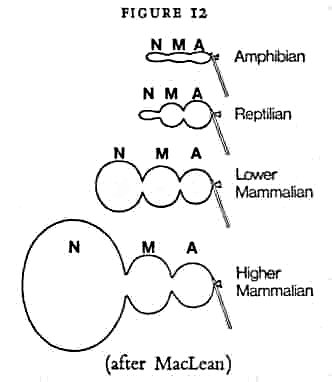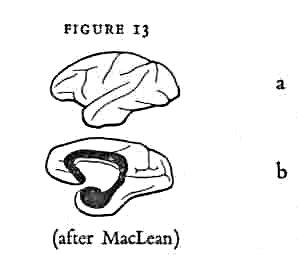The Ghost in the Machine (42 page)

Man finds himself in the predicament that Nature has endowed him
essentially with three brains which, despite great differences
in structure, must function together and communicate with one
another. The oldest of these brains is basically reptilian. The
second has been inherited from lower mammals, and the third is a
late mammalian development, which in its culmination in primates,
has made man peculiarly man.
Speaking allegorically of these three brains within a brain, we
might imagine that when the psychiatrist bids the patient to lie
on the couch, he is asking him to stretch out alongside a horse and
a crocodile. The crocodile may be willing and ready to shed a tear
and the horse to neigh and whinny, but when they are encouraged to
express their troubles in words, it soon becomes evident that their
inability is beyond the help of language training. Little wonder that
the patient who has personal responsibility for these animals and who
must serve as their mouthpiece is sometimes accused of being full of
resistances and reluctant to talk. . . . [15] The reptilian brain
is filled with ancestral lore and ancestral memories and is faithful
in doing what its ancestors say, but it is not a very good brain for
facing up to new situations. It is as though it were neurosis-bound
to an ancestral superego.
In evolution one first sees the beginning of emancipation
from the ancestral superego with the appearance of the lower
mammalian brain, which Nature builds on top of the reptilian
brain. . . . Investigations of the last twenty years have shown
that the lower mammalian brain plays a fundamental role in emotional
behaviour. . . . It has a greater capacity than the reptilian brain
for learning new approaches and solutions to problems on the basis
of immediate experience. But like the reptilian brain, it does not
have the ability . . . to put its feelings into words. [16]
experimental work and theoretical conclusions (though deviating from
the latter in minor details). The great attraction of the theory is
its consistently hierarchic approach, in the sense in which this
term is used in the present book. 'In its evolution', he writes,
'the brain of man retains the hierarchical organisation of the
three basic types which can be conveniently labelled as reptilian,
paleo-mammalian and neo-mammalian. The limbic system [see below]
represents the paleo-mammalian brain, which is an inheritance from lower
mammals. Man's limbic system is much more highly structured than that
of lower animals, but its basic organisation, chemistry, etc., are very
similar. The same may be said of the other two basic types. And there is
ample evidence that all three types have their own special subjective,
cognitive (problem-solving) memory and other parallel functions.' [17]
We can paraphrase this by saying that each functions as a relatively
autonomous holon on its own level.
but a few remarks about the evolution of the brain may be helpful
at this point. The ancient anatomists compared the brain to a fruit
like an orange: the central part is like the pulp, the outer like the
rind; so the former was named medulla, the latter cortex. The medulla
is a prolongation of the spinal cord, and is further prolonged into
the
brain-stem
. Inside or near to it are clusters and structures
of cell masses such as the hypothalamus, the reticular system, the
basal ganglia. This is the phylogenetically oldest part of the brain,
its core or chassis, roughly corresponding to the basic structures of
the reptile's brain. It contains the essential apparatus for internal
(visceral and glandular) regulations, for primitive activities based on
instincts and reflexes, and also the centres for arousing the animal's
vigilance or putting it to sleep. The cortex or rind, on the other hand,
is the apparatus for 'intelligent' behaviour, from the capacity to acquire
new responses by whatever primitive form of learning, up to conceptual
thought. The cortex emerges at the stage of evolutionary history when
the amphibians began to turn into reptiles; the first promising cortical
divisions are found in the turtle. The cortex is the surface-layer of the
cerebral hemispheres
which grow out of the brain-stem and fold around
it like a cloak or mantle (hence 'pallium'). It consists of the outer,
'grey' cortical layer of cell bodies, and the white fibres underlying
it. The human cortex is about a tenth of an inch thick and contains about
ten thousand million neurons densely packed together, covering an area of
about three square feet, crammed into the
gyri
and
sulki
,
convolutions and invaginations of the crinkled sheet. Truly a staggering
feat of circuitry -- and yet . . .
idea of the basic structure of the brain; but beyond that it becomes
misleading. The cortex, unlike the rind of the orange, is not
homogeneous. Different types of nerve cells dominate in different
functional areas; and more than a hundred different areas have been
mapped, numbered, or named according to their microscopic structure
and other criteria. But although the details of these classifications
are controversial, there is general agreement that, judged by their
evolutionary history and by their distinctive texture, the cortex has
three basic sub-divisions. The older anatomists called them archipallium,
paleopallium and neopallium; MacLean calls them archicortex, mesocortex
and neocortex, co-ordinated respectively with the reptilian, primitive
mammalian and neo-mammalian brain. But the spatial arrangement of these
three main cortical divisions inside our skulls is not easy to explain
or visualise; MacLean proposed a simplified model in the form of an
inflatable toy balloon with three distinct segments (Figure 12). [18]

,
M
and
N
stand for
archi
,
meso
and
neo
cortex. 'The uninflated balloon represents the situation
found in the amphibian. With the appearance of the reptile, there is
a ballooning out of the archicortex and a considerable expansion of the
mesocortex. During the phylogeny of the mammal, one of the most striking
events of all evolution occurs. This is the great ballooning out of the
neocortex. In the process, the archicortex and the greater part of the
mesocortex are folded like two concentric rings into the limbic lobe and
are relegated, as it were, to the cellar of the brain' (Figure 13). [19]

is a side-view, and (b) a vertical cross-section of a monkey's brain. The
two in-folded rings together form a large convolution, the so-called
limbic lobe of the cerebral cortex, shown in black. 'Limbic' means
'hemming in', 'forming a border around'; the term was coined in 1878 by
the great brain-mapper, Broca, because the limbic convolution surrounds
the brain-stem -- the central core (not shown on the diagram). In fact,
the limbic cortex is so closely connected to the brain-stem that together
they constitute a functionally integrated system -- the 'limbic system'
with its 'reptilian' and 'primitive-mammalian' features. The limbic
system may thus be loosely called the 'old brain', in contrast to the
'neocortical system' or 'new brain'.
a kind of common denominator in the brains of all mammals. . . . The
faithful preservation of this cortex through the phylogeny of the mammals
contrasts with the rapid evolution and growth of the neocortex around it,
the latter representing the growth of intellectual function. . . . The
limbic cortex is structurally primitive compared to the neocortex;
it shows essentially the same degree of development and organisation
throughout the mammalian series. This would suggest that it functions
on an animalistic level in both animal and man.' [20]
us the contrary, we would expect an evolutionary development which
gradually transformed the primitive old brain into a more sophisticated
instrument -- as it transformed claw into hand, gill into lung. Instead,
evolution
superimposed a new, superior structure on an old one
, with
partly overlapping functions, and
without providing the new with a
clear-cut, hierarchic control over the old
-- thus inviting confusion
and conflict. Let us have a closer look at this dichotomy between the
limbic and neocortical systems.
animal a combined picture of the outside and inside worlds. This is
a useful analogy for the limited purpose for which he employs it. But
to avoid misunderstandings I would like, before making use of it, to
point out its limitations. Of all parts of the body the cerebral cortex
is the most intimately connected with awareness and self-awareness;
but it would be wrong to call it -- as is sometimes done -- the
seat
of awareness. To quote that wise mechanist, Judson Herrick: 'The search
for a
seat
of consciousness in general or of any particular kind of
conscious experience is a pseudo-problem because the conscious act has
properties that are not definable in terms of the spatial and temporal
units which are employed in the measurement of the objects and events
of our objective world. What we search for and find by objective inquiry
is the apparatus which generates awareness. This mechanism has locus in
space and time, but the awareness as such is not located in any particular
part of the mechanism' (my italics). [21]
'apparatus which generates awareness'. The ancient structures in the
brain-stem may be said to provide the 'raw material' of awareness: the
reticular formation 'arouses' the animal; the hypothalamic structures
contribute the visceral component; but ultimately 'the cerebral cortex
is to the brain what the television screen is to the television set
and what a radar screen is to the pilot'. [22] If this is the case,
we must face the paradox that evolution has provided us with at least
two such screens, one ancient, one new.
characteristics: (a) its microscopic structure is coarse and primi- tive
compared to the neocortex; (b) its basic pattern is still essentially
the same as in the lower mammals; (c) in contrast to the new cortex,
the limbic system is intimately connected by two-way neural pathways --
fibres as thick as a pencil -- with the hypothalamus and other centres
in the brain-stem concerned with visceral sensations and emotional
reactions including sex, hunger, fear and aggression; so much so that
the limbic system once bore the name 'the visceral brain'.* The term
was changed because it gave the impression that it was
only
concerned with the viscera; whereas in fact the ancient, limbic cortex,
as we shall presently see, also has its own mental processes: it emotes
and
thinks
-- though not in verbal concepts.
* Even earlier the limbic cortex was called the rhinencephalon,
i.e., small brain, because it was thought to be exclusively
concerned with smell.
which combines, and often confuses, projections from the internal,
visceral environment with the external environment. 'Such a cortex must
have offered some of the confusion of a twice-exposed film. In any
event, it could not have been altogether satisfactory, because when
Nature proceeded to develop the neo-mammalian brain, she constructed
progressively a bigger and finer type of screen, which gave predominantly
a picture of the outside world made up of impressions from the eye,
the ear and the surface of the body. . . . But Nature in her frugality
did not discard the old screen. Since it seemed adequate for smelling,
tasting and feeling what is going on inside the body, she has kept the
ftlaments in the tube of the old screen glowing night and day.' [23]
Other books
Eternity (Circle of Light) by April Margeson
How You Remind Me by Julie Leto
Flirting with Disaster by Sherryl Woods
Tom Swift and His Polar-Ray Dynasphere by Victor Appleton II
Totlandia: The Onesies, Book 1 (Fall) by Josie Brown
Tenacious Trents 03 - A Reluctant Rake by Jane Charles
Controversy Creates Cash by Eric Bischoff
"Non-Germans" Under the Third Reich by Diemut Majer
A Head for Poisoning by Simon Beaufort
Lieutenant (An Ell Donsaii story #3) by Dahners, Laurence
